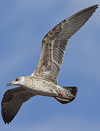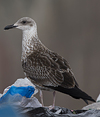 nominate Lesser Black-backed Gull (L. f. fuscus)
nominate Lesser Black-backed Gull (L. f. fuscus)
(last update:
Amir Ben Dov (Israel)
Hannu Koskinen (Finland)
Mars Muusse (the Netherlands)
fuscus 1cy July
fuscus 1cy Aug
fuscus 1cy Sept
fuscus 1cy Oct
fuscus 1cy Nov
fuscus 1cy Dec
fuscus 2cy Jan
fuscus 2cy Feb
fuscus 2cy March
fuscus 2cy April
fuscus 2cy May
fuscus 2cy June
fuscus 2cy July
fuscus 2cy Aug
fuscus 2cy Sept
fuscus 2cy Oct
fuscus 2cy Nov
fuscus 2cy Dec
fuscus 3cy Jan
fuscus 3cy Feb
fuscus 3cy March
fuscus 3cy April
fuscus 3cy May
fuscus 3cy June
fuscus 3cy July
fuscus 3cy August
fuscus 3cy Sept
fuscus 3cy October
fuscus 3cy Nov
fuscus 3cy Dec
fuscus 4cy Jan
fuscus 4cy Feb
fuscus 4cy March
fuscus 4cy April
fuscus 4cy May
fuscus 4cy June
fuscus 4cy July
fuscus 4cy Aug
fuscus 4cy Sept
fuscus 4cy Oct
fuscus 4cy Nov
fuscus 4cy Dec
fuscus ad Jan
fuscus ad Feb
fuscus ad March
fuscus ad April
fuscus ad May
fuscus ad June
fuscus ad July
fuscus ad Aug
fuscus unringed Aug
fuscus ad Sept
fuscus ad Oct
fuscus ad Nov
fuscus ad Dec
Northern Norway: breeding ground for dark-mantled and pale-mantled LBBG
Traditionally, two subspecies of LBBG could be found in Norway: dark-mantled nominate fuscus in the north and pale-mantled intermedius in the south. Last decades, nominate fuscus breeding figures have dropped dramatically, while those figures for pale-mantled birds have increased. Nowadays (but already from the late 1980's) pale-mantled birds, either with origins in graellsii-land or colonisers from south Norwegian intermedius-land can be found way up in northern Norway.
The likelihood of mixed pairing becomes larger. It is interesting to see how these populations evolve, both in phenotypics and in migration strategy. There has been a publication on interbreeding (foster parents in fuscus x argentatus). The summary is copied below.
ABNORMAL MIGRATION AND HYBRIDIZATION OF LARUS ARGENTATUS AND L. FUSCUS AFTER INTERSPECIES FOSTERING EXPERIMENTS
M. P. Harris, 1970 IN: Ibis, Volume 112, Issue 4, pages 488–498, October 1970
Summary
Between 1962 and 1966 eggs of Larus argentatus and L. fuscus were interchanged and almost 900 young were reared by the wrong species. Many of these cross-fostered young were later recovered or retrapped on and away from the colonies.
The British population of argentatus is sedentary and ringed birds are not recovered outside Britain, whereas fuscus normally migrates. Many cross-fostered argentatus migrated to France, Spain and Portugal, areas where fuscus is common, but they did not migrate as far as the control fuscus. It is possible that these cross-fostered argentatus had followed their foster parents when these migrated, but this is unlikely as the cross-fostered fuscus also migrated although their foster parents would have remained in Britain.
Despite wide ecological and behavioural overlaps, interbreeding between L. argentatus and L. fuscus is exceedingly rare. However, as a result of cross-fostering experiments, 31 and 40 mixed pairs were found on Skokholm in 1968 and 1969 respectively. Although some of the birds involved were unringed it is probable that all the adults in mixed pairs had been cross-fostered. Other cross-fostered birds were found mated with their own species and it appears that the sex of the imprinted birds was important. Female gulls will usually only mate with males of their own species, or in the case of the cross-fostered birds, with males of their foster species. Males will mate with either species.
Evidence is given that suggests that the colour of the mantle and wings is important in species recognition at long range, and the colour of eye-ring and join of the mandibles for recognition at short range. The role of voice is uncertain but general behaviour is probably unimportant.
 L. f. fuscus 1cy C.8C3 December 06 2013, Ashdod, Israel. Picture: Amir Ben Dov.
L. f. fuscus 1cy C.8C3 December 06 2013, Ashdod, Israel. Picture: Amir Ben Dov. L. f. fuscus 1cy CN95 December 2006 - January 2007, Groningen, the Netherlands. Juvenile fuscus.
L. f. fuscus 1cy CN95 December 2006 - January 2007, Groningen, the Netherlands. Juvenile fuscus. L. f. fuscus 1cy CRX0 December 08 2009, Ashdod, Israel. Image: Yoav Perlman. Juvenile fuscus.
L. f. fuscus 1cy CRX0 December 08 2009, Ashdod, Israel. Image: Yoav Perlman. Juvenile fuscus. L. f. fuscus 1cy CSC9 December 23 2009, Ashdod, Israel. Picture: Amir Ben Dov.
L. f. fuscus 1cy CSC9 December 23 2009, Ashdod, Israel. Picture: Amir Ben Dov. L. f. fuscus 1cy CM9V December 17 2013 Banugues - Asturias, Spain. Picture: José Antonio García Canal.
L. f. fuscus 1cy CM9V December 17 2013 Banugues - Asturias, Spain. Picture: José Antonio García Canal.
 L. f. fuscus 1cy December 14 2013, Ashdod, Israel. Picture: Amir Ben Dov. Juvenile plumage.
L. f. fuscus 1cy December 14 2013, Ashdod, Israel. Picture: Amir Ben Dov. Juvenile plumage. and armenian (front) 2nd CY BQ4R9104 Ashdod 14.12.13.jpg) L. f. fuscus 1cy December 14 2013, Ashdod, Israel. Picture: Amir Ben Dov. Juvenile plumage.
L. f. fuscus 1cy December 14 2013, Ashdod, Israel. Picture: Amir Ben Dov. Juvenile plumage. L. f. fuscus 1cy December 11 2010, Ashdod, Israel. Picture: Amir Ben Dov. Juvenile plumage.
L. f. fuscus 1cy December 11 2010, Ashdod, Israel. Picture: Amir Ben Dov. Juvenile plumage. L. f. fuscus 1cy December 11 2010, Ashdod, Israel. Picture: Amir Ben Dov.
L. f. fuscus 1cy December 11 2010, Ashdod, Israel. Picture: Amir Ben Dov. L. f. fuscus 1cy December 11 2009, Ashdod, Israel. Picture: Amir Ben Dov. Moulting scapulars.
L. f. fuscus 1cy December 11 2009, Ashdod, Israel. Picture: Amir Ben Dov. Moulting scapulars. L. f. fuscus 1cy December 15 2012, Ashdod, Israel. Picture: Amir Ben Dov. Old scapulars.
L. f. fuscus 1cy December 15 2012, Ashdod, Israel. Picture: Amir Ben Dov. Old scapulars. L. f. fuscus 1cy December 23 2011, Ashdod, Israel. Picture: Amir Ben Dov.
L. f. fuscus 1cy December 23 2011, Ashdod, Israel. Picture: Amir Ben Dov.